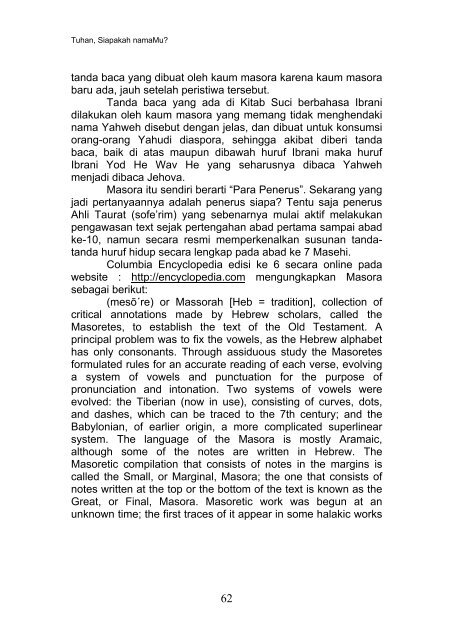Create successful ePaper yourself
Turn your PDF publications into a flip-book with our unique Google optimized e-Paper software.
Tuhan, Siapakah namaMu?<br />
tanda baca yang dibuat oleh kaum masora karena kaum masora<br />
baru ada, jauh setelah peristiwa tersebut.<br />
Tanda baca yang ada di Kitab Suci berbahasa Ibrani<br />
dilakukan oleh kaum masora yang memang tidak menghendaki<br />
nama Yahweh disebut dengan jelas, dan dibuat untuk konsumsi<br />
orang-orang Yahudi diaspora, sehingga akibat diberi tanda<br />
baca, baik di atas maupun dibawah huruf Ibrani maka huruf<br />
Ibrani Yod He Wav He yang seharusnya dibaca Yahweh<br />
menjadi dibaca Jehova.<br />
Masora itu sendiri berarti “Para Penerus”. Sekarang yang<br />
jadi pertanyaannya adalah penerus siapa? Tentu saja penerus<br />
Ahli Taurat (sofe’rim) yang sebenarnya mulai aktif melakukan<br />
pengawasan text sejak pertengahan abad pertama sampai abad<br />
ke-10, namun secara resmi memperkenalkan susunan tandatanda<br />
huruf hidup secara lengkap pada abad ke 7 Masehi.<br />
Columbia Encyclopedia edisi ke 6 secara online pada<br />
website : http://encyclopedia.com mengungkapkan Masora<br />
sebagai berikut:<br />
(mesō´re) or Massorah [Heb = tradition], collection of<br />
critical annotations made by Hebrew scholars, called the<br />
Masoretes, to establish the text of the Old Testament. A<br />
principal problem was to fix the vowels, as the Hebrew alphabet<br />
has only consonants. Through assiduous study the Masoretes<br />
formulated rules for an accurate reading of each verse, evolving<br />
a system of vowels and punctuation for the purpose of<br />
pronunciation and intonation. Two systems of vowels were<br />
evolved: the Tiberian (now in use), consisting of curves, dots,<br />
and dashes, which can be traced to the 7th century; and the<br />
Babylonian, of earlier origin, a more complicated superlinear<br />
system. The language of the Masora is mostly Aramaic,<br />
although some of the notes are written in Hebrew. The<br />
Masoretic compilation that consists of notes in the margins is<br />
called the Small, or Marginal, Masora; the one that consists of<br />
notes written at the top or the bottom of the text is known as the<br />
Great, or Final, Masora. Masoretic work was begun at an<br />
unknown time; the first traces of it appear in some halakic works<br />
62


